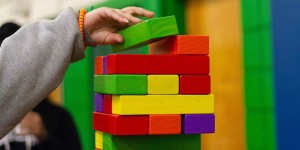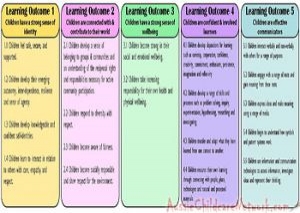EYLF Learning Outcome 1 - Children Have A Strong Sense Of Identity focuses on children developing a strong sense of identity. The following article provides Key Learning Goals associated with this outcome.
Key Learning Goals
EYLF Learning Outcome 1 focuses on children developing a strong sense of identity. This outcome emphasizes the importance of children feeling safe, secure, and supported, which helps them grow in confidence to explore and learn. Key learning goals include:
-
1Children feel safe, secure, and supported:
- Build secure attachments with familiar educators.
- Use effective routines to help make predicted transitions smoothly.
- Communicate their needs for comfort and assistance.
- Establish and maintain respectful, trusting relationships with others.
- Openly express their feelings and ideas in interactions with others.
-
Children develop their emerging autonomy, interdependence, resilience, and sense of agency:
- Demonstrate increasing awareness of the needs and rights of others.
- Be open to new challenges and discoveries.
- Cooperate and work collaboratively with others.
- Take considered risks in decision-making and cope with the unexpected.
- Recognize their individual achievements and those of others.
-
Children develop knowledgeable and confident self-identities and a positive sense of worth.
- Explore different aspects of identity through play and relationships.
- Develop a sense of belonging when they feel accepted and develop attachments.
- Engage confidently with social and physical environments through relationships and play.
-
Children learn to interact in relation to others with care, empathy, and respect:
- Initiate interactions and conversations with trusted educators.
- Respond to ideas and suggestions from others.
- Demonstrate empathy and respect in their interactions.
As an early childhood educator, you can promote these goals by:
- Responding sensitively to children’s cues and signals.
- Supporting secure attachments through consistent and warm nurturing relationships.
- Encouraging children to express their thoughts and feelings.
- Creating an inclusive environment that respects each child’s uniqueness.
Strategies To Support Learning Goals
1. Children feel safe, secure, and supported
-
Consistent Routines: Establish and maintain predictable routines to help children feel secure. Use visual schedules to help them understand what comes next.
-
Responsive Interactions: Pay close attention to children’s cues and respond promptly and sensitively. This helps build trust and a sense of security.
-
Comfort Objects: Allow children to bring comfort objects from home, which can provide a sense of security in the classroom.
2. Children develop their emerging autonomy, interdependence, resilience, and sense of agency
-
Choice and Independence: Offer choices in activities and encourage children to make decisions. This fosters a sense of control and independence.
-
Problem-Solving Opportunities: Create scenarios where children can solve problems independently or with peers. This builds resilience and collaborative skills.
-
Risk-Taking in Play: Provide safe opportunities for children to take risks, such as climbing or balancing activities, to build confidence and resilience.
3. Children develop knowledgeable and confident self-identities and a positive sense of self-worth
-
Cultural Celebrations: Incorporate cultural celebrations and traditions into your curriculum to help children explore their own and others’ identities.
-
Self-Expression Activities: Use art, music, and storytelling to allow children to express themselves and explore different aspects of their identity.
-
Positive Reinforcement: Acknowledge and celebrate individual achievements to build self-esteem and confidence.
4. Children learn to interact in relation to others with care, empathy, and respect
-
Modeling Behavior: Demonstrate respectful and empathetic behavior in your interactions with children and adults. Children learn a lot by observing.
-
Role-Playing: Use role-playing activities to teach empathy and perspective-taking. For example, acting out different scenarios where children practice caring for others.
-
Collaborative Projects: Engage children in group projects where they need to work together, share resources, and support each other.
Additional Tips:
-
Inclusive Environment: Ensure your classroom environment reflects the diversity of the children. Include books, toys, and materials that represent different cultures, abilities, and family structures.
-
Family Involvement: Involve families in the learning process. Regularly communicate with parents and invite them to share their cultural practices and traditions.
-
Strengths-Based Approach: Focus on each child’s strengths and interests. Use these as a foundation for planning activities and interactions.
Activities That Link To EYLF Learning Outcome 1
Here are some specific activities that align with the learning goals of EYLF Learning Outcome 1:
1. Children feel safe, secure, and supported
-
Morning Circle Time: Start the day with a morning circle where children can share their feelings and experiences. This helps them feel connected and supported.
-
Personalized Greetings: Greet each child by name and with a warm smile or hug (if appropriate) as they arrive. This helps them feel welcomed and valued.
-
Comfort Corners: Create a cozy corner with soft pillows, blankets, and books where children can go if they need a break or some comfort.
2. Children develop their emerging autonomy, interdependence, resilience, and sense of agency
-
Choice Boards: Use choice boards where children can select activities they are interested in. This encourages decision-making and independence.
-
Problem-Solving Games: Introduce games that require children to work together to solve problems, such as building a structure with blocks or completing a puzzle.
-
Outdoor Exploration: Plan outdoor activities that involve physical challenges, like obstacle courses, to help children build resilience and confidence.
3. Children develop knowledgeable and confident self-identities and a positive sense of self-worth
-
All About Me Books: Have children create “All About Me” books where they can include drawings, photos, and stories about themselves and their families.
-
Cultural Show-and-Tell: Organize a show-and-tell where children can bring items from home that represent their culture or family traditions.
-
Mirror Play: Use mirrors in play areas to encourage children to explore their reflections and talk about what makes them unique.
4. Children learn to interact in relation to others with care, empathy, and respect
-
Buddy System: Pair children up as buddies for certain activities to encourage them to support and help each other.
-
Empathy Stories: Read stories that focus on themes of empathy and kindness, and discuss the characters’ feelings and actions.
-
Group Art Projects: Engage children in collaborative art projects where they need to share materials and ideas, fostering cooperation and respect.
Additional Activities:
-
Family Tree Projects: Have children create family trees with photos and drawings, which can be displayed in the classroom to celebrate diversity and family connections.
-
Community Helpers: Invite community helpers (like firefighters, nurses, or police officers) to visit the classroom and talk about their roles, helping children understand and respect different professions.
-
Celebration of Differences: Plan activities that celebrate different cultures, languages, and abilities, such as multicultural days or inclusive games.
Lesson Plan Sample For EYLF Outcome 1
Here’s a sample lesson plan designed to support EYLF Learning Outcome 1, which focuses on children developing a strong sense of identity:
Lesson Plan: “All About Me”
Objective:
To help children develop a strong sense of identity by exploring their own unique characteristics and those of their peers.
Learning Goals:
- Children feel safe, secure, and supported.
- Children develop their emerging autonomy, interdependence, resilience, and sense of agency.
- Children develop knowledgeable and confident self-identities.
- Children learn to interact in relation to others with care, empathy, and respect.
Materials Needed:
- Mirrors
- Art supplies (crayons, markers, paper, glue, scissors)
- Family photos
- Books about diversity and self-identity
- Large paper for a group mural
- Comfort objects (optional)
Activities:
1. Morning Circle Time (15 minutes)
-
Greeting: Welcome each child by name and with a warm greeting.
-
Discussion: Talk about the day’s activities and what it means to feel safe and supported. Encourage children to share what makes them feel secure.
2. Self-Portrait Activity (30 minutes)
-
Introduction: Provide each child with a mirror and ask them to look at their reflection. Discuss the unique features they see.
-
Art Creation: Have children draw or paint self-portraits using the art supplies. Encourage them to include details that make them unique (e.g., hair color, favorite clothes).
-
Sharing: Allow children to share their self-portraits with the group and talk about what they like about themselves.
3. Family Tree Project (45 minutes)
-
Preparation: Ask children to bring family photos from home.
-
Activity: Help children create a family tree using the photos and art supplies. Discuss the different family members and their roles.
-
Discussion: Talk about how families are different and special. Encourage children to share stories about their families.
4. Story Time (20 minutes)
-
Book Reading: Read a book that celebrates diversity and self-identity, such as “The Colors of Us” by Karen Katz or “It’s Okay to Be Different” by Todd Parr.
-
Discussion: Discuss the themes of the book and how it relates to the children’s own experiences.
5. Group Mural (30 minutes)
-
Activity: Create a large mural that represents the classroom community. Each child can add a drawing or handprint to the mural.
-
Collaboration: Encourage children to work together and discuss what they are adding to the mural.
6. Reflection and Closing (15 minutes)
-
Reflection: Gather the children and reflect on the day’s activities. Ask them what they enjoyed and what they learned about themselves and their friends.
-
Closing: End with a calming activity, such as a short mindfulness exercise or a song that promotes a sense of belonging and community.
Assessment:
-
Observe children’s participation and engagement in activities.
-
Note children’s ability to express their feelings and ideas.
-
Assess children’s understanding of their own and others’ identities through discussions and activities.
This lesson plan aims to create a supportive and inclusive environment where children can explore their identities and build strong, respectful relationships with others.
These activities not only support the learning goals of EYLF Learning Outcome 1 but also create a rich, inclusive, and engaging learning environment for all children. EYLF Learning Outcome 1 is crucial as it lays the foundation for children’s overall development and well-being. It helps them build a positive self-esteem, understand and respect diversity, and develop the social skills necessary for interacting with others.
Further Reading
EYLF Learning Outcomes Version 2.0 - The following articles list the 5 EYLF Learning Outcomes and their sub-outcomes (Version 2.0).
EYLF Outcome 2 - Children Are Connected With And Contribute To Their World V2.0 - The following lists the sub-outcomes, examples of evidence when children achieve each sub-outcome and how educators can promote and help children to achieve EYLF Outcome 2 - Children Are Connected With And Contribute To Their World V2.0.
EYLF Outcome 3 - Children Have A Strong Sense Of Wellbeing V2.0 - The following lists the sub-outcomes, examples of evidence when children achieve each sub-outcome and how educators can promote and help children to achieve EYLF Outcome 3 - Children Have A Strong Sense Of Wellbeing V2.0.
EYLF Outcome 4 - Children Are Confident And Involved Learners V2.0 - The following lists the sub-outcomes, examples of evidence when children achieve each sub-outcome and how educators can promote and help children to achieve EYLF Outcome 4 - Children Are Confident And Involved Learners V2.0.
EYLF Outcome 5 - Children Are Effective Communicators V2.0 - The following lists the sub-outcomes, examples of evidence when children achieve each sub-outcome and how educators can promote and help children to achieve EYLF Outcome 5 - Children Are Effective Communicators V2.0.
References:
Learning Outcomes and the EYLF, Making Education
The EYLF Framework, ACECQA







 Here is the list of the EYLF Learning Outcomes that you can use as a guide or reference for your documentation and planning. The EYLF
Here is the list of the EYLF Learning Outcomes that you can use as a guide or reference for your documentation and planning. The EYLF The EYLF is a guide which consists of Principles, Practices and 5 main Learning Outcomes along with each of their sub outcomes, based on identity,
The EYLF is a guide which consists of Principles, Practices and 5 main Learning Outcomes along with each of their sub outcomes, based on identity, This is a guide on How to Write a Learning Story. It provides information on What Is A Learning Story, Writing A Learning Story, Sample
This is a guide on How to Write a Learning Story. It provides information on What Is A Learning Story, Writing A Learning Story, Sample One of the most important types of documentation methods that educators needs to be familiar with are “observations”. Observations are crucial for all early childhood
One of the most important types of documentation methods that educators needs to be familiar with are “observations”. Observations are crucial for all early childhood To support children achieve learning outcomes from the EYLF Framework, the following list gives educators examples of how to promote children's learning in each individual
To support children achieve learning outcomes from the EYLF Framework, the following list gives educators examples of how to promote children's learning in each individual Reflective practice is learning from everyday situations and issues and concerns that arise which form part of our daily routine while working in an early
Reflective practice is learning from everyday situations and issues and concerns that arise which form part of our daily routine while working in an early Within Australia, Programming and Planning is reflected and supported by the Early Years Learning Framework. Educators within early childhood settings, use the EYLF to guide
Within Australia, Programming and Planning is reflected and supported by the Early Years Learning Framework. Educators within early childhood settings, use the EYLF to guide This is a guide for educators on what to observe under each sub learning outcome from the EYLF Framework, when a child is engaged in
This is a guide for educators on what to observe under each sub learning outcome from the EYLF Framework, when a child is engaged in When observing children, it's important that we use a range of different observation methods from running records, learning stories to photographs and work samples. Using
When observing children, it's important that we use a range of different observation methods from running records, learning stories to photographs and work samples. Using The Early Years Learning Framework describes the curriculum as “all the interactions, experiences, activities, routines and events, planned and unplanned, that occur in an environment
The Early Years Learning Framework describes the curriculum as “all the interactions, experiences, activities, routines and events, planned and unplanned, that occur in an environment


